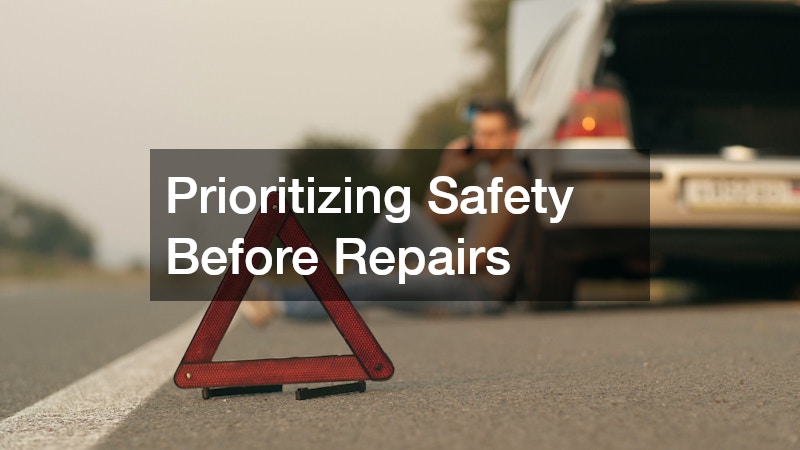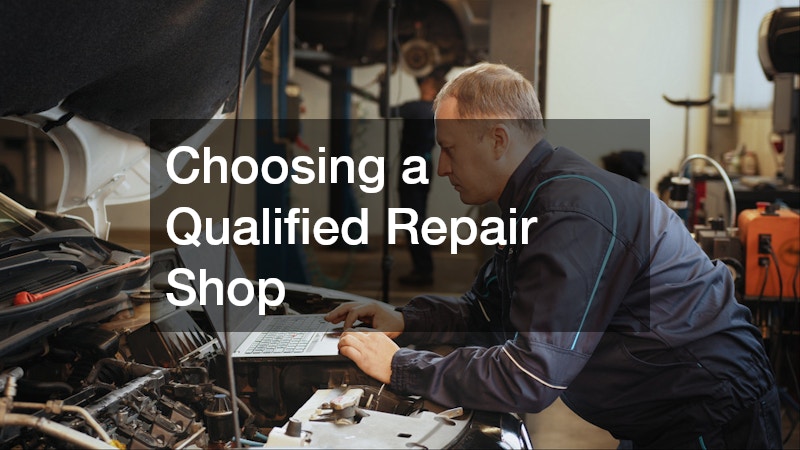Truck damage can be a frustrating and disruptive experience, affecting not only your vehicle’s appearance but also its safety and performance. Whether the cause is an accident, adverse weather conditions, or daily wear and tear, the repair process can feel overwhelming. In addition to the financial impact, dealing with the logistics of inspections, insurance claims, and repair timelines can test your patience. Understanding how to approach the situation with a clear plan can help reduce stress and ensure that your truck gets back on the road in the best possible condition.
Taking the time to learn the steps involved in addressing truck damage will give you greater confidence during an already challenging time. From the initial assessment to choosing the right repair solutions, knowing what to expect allows you to make informed decisions that protect your investment. Even when the situation feels urgent, slowing down enough to evaluate your options will help you avoid costly mistakes and ensure repairs are done correctly.
It’s also worth noting that having a clear process in mind before any incident occurs can make a big difference in how you handle unexpected damage. Familiarizing yourself with common repair terms, local service providers, and your insurance policy means you won’t be starting from scratch during a stressful situation. Preparation not only speeds up recovery but also gives you peace of mind knowing you have a plan in place.
Assessing the Extent of the Damage

The first step in dealing with damage is to carefully evaluate the extent of the problem. A thorough assessment helps determine whether the damage is purely cosmetic, structural, or a combination of both. Looking closely at dents, scratches, and alignment issues can reveal whether the vehicle is safe to drive or needs immediate attention. This evaluation also gives you a better understanding of potential repair costs, which can influence how you move forward with insurance claims or out-of-pocket expenses.
When assessing truck damage, don’t overlook the small details, such as loose panels or broken truck accessories, as they can worsen over time if left unaddressed. Taking detailed notes and photographs from multiple angles will help you track any changes and provide essential evidence for insurance purposes. It’s also wise to consult a trusted mechanic or body shop for a professional opinion, as they may spot issues that aren’t visible to the untrained eye.
Documenting the Incident Thoroughly
Once truck damage has been identified, the next crucial step is to document the incident as thoroughly as possible. This documentation serves as a record of events and protects you in case of disputes with insurance providers or repair shops. Written descriptions, date and time records, and visual evidence like photos and videos all work together to establish the facts clearly. The more comprehensive your documentation, the easier it will be to communicate with all parties involved.
In some cases, the damage might involve other equipment or vehicles, such as forklift parts if the incident occurred in a warehouse or loading dock. In these situations, recording details about the surrounding environment, witnesses, and any contributing factors will strengthen your case. Keeping all your evidence organized in a dedicated folder or digital file ensures quick access when you need to share it with insurers, law enforcement, or repair professionals.
Contacting Your Insurance Provider Promptly

After identifying and documenting your damage, it’s important to reach out to your insurance provider as soon as possible. Prompt communication allows your claim to be processed quickly and ensures that important deadlines are met. Insurance representatives can walk you through the necessary steps, explain your coverage, and advise you on what documentation is required. Acting quickly also helps prevent any misunderstandings that could delay your repairs.
If the truck damage is severe enough to require heavy towing, notifying your insurer immediately becomes even more critical. Some insurance policies have preferred towing partners, and using them can save you both time and money. Be sure to confirm whether the towing service is covered under your plan and whether it will be billed directly to your insurer or to you. This proactive approach prevents unnecessary expenses and gets your truck on the path to repair faster.
Obtaining Multiple Repair Estimates
When it comes to repairing damage, getting multiple estimates ensures you’re making an informed decision. Prices and services can vary widely between repair shops, so comparing quotes gives you a clearer picture of fair market rates. In addition, reviewing different approaches to the repair can help you understand your options, including whether to prioritize cost, speed, or the highest quality materials.
Some repairs might involve specialized finishes, such as powder coating, to restore the truck’s appearance and durability. If that’s the case, ask each shop about the materials and techniques they use to ensure the results will last. By weighing the details of each estimate alongside cost, you’ll be in a better position to choose a repair plan that balances quality with budget.
Prioritizing Safety Before Repairs

Even if you’re eager to have your truck damage repaired, safety should always come first. Driving a damaged truck can put you and others at risk, especially if structural integrity, braking, or steering has been compromised. Before deciding to drive the vehicle, consider whether it needs to be towed to a repair facility instead. Taking this precaution helps prevent further damage and ensures you’re not violating any safety regulations.
Working with a reliable tow service company can make the process smoother and more secure. These professionals have the right equipment and training to handle trucks safely, even in challenging situations. They can also transport your truck directly to the repair shop of your choice, saving you time and reducing the stress of coordinating multiple services on your own.
Understanding Your Coverage Options
Before committing to any repair plan, it’s essential to understand what your insurance policy actually covers in the event of damage. Coverage levels can vary significantly between policies, with some paying for full repairs while others only cover partial costs or specific types of damage. Reading through your policy and asking your insurer direct questions can prevent costly surprises down the road.
Sometimes, coverage extends beyond just trucks—policies might also include other vehicles or equipment, such as golf carts, if they were involved in the same incident. Knowing these details can help you make the most of your benefits and ensure that all damaged property is accounted for in your claim. This clarity can also guide you in choosing the right repair solutions without exceeding your budget.
Choosing a Qualified Repair Shop

Selecting the right repair shop is a critical step in restoring your truck after damage. A reputable shop will have skilled technicians, the right tools, and experience working on your specific type of truck. Checking reviews, asking for referrals, and verifying certifications can help you find a provider you can trust. Quality workmanship ensures that your repairs will last and that your truck will be safe to operate.
If your truck damage is extensive—such as involving large dents, frame misalignment, or mechanical failures—look for a shop experienced in working with heavy equipment. This type of expertise means they are better equipped to handle substantial repairs that go beyond cosmetic fixes. A qualified repair shop won’t just make your truck look better; they’ll restore its performance and reliability.
Managing Repair Timelines Effectively
Repair timelines can vary greatly depending on the extent of the work and the availability of parts when dealing with damage. Managing these timelines effectively ensures that you’re not left without transportation longer than necessary. Communicating regularly with your repair shop and confirming their estimated completion date helps keep the process on track.
Some repairs, such as a transmission replacement, can require additional time due to the complexity of the work and the need to source specific parts. Understanding these factors in advance allows you to make arrangements for temporary transportation and plan your schedule accordingly. Staying informed throughout the process reduces frustration and helps you anticipate when your truck will be back on the road.
Another useful strategy for managing repair timelines is to clarify expectations in writing. Having a documented repair agreement that includes the estimated completion date, scope of work, and any contingencies can help avoid misunderstandings later. This also gives you a clear reference point if delays occur, allowing you to address them promptly and professionally. By maintaining open communication and holding all parties accountable, you can minimize downtime and get your truck back in service as soon as possible.
Preventing Future Truck Damage
While repairing current damage is important, taking steps to prevent future issues can save you time, money, and stress. Regular maintenance checks, cautious driving habits, and proper loading procedures can all help reduce the risk of damage. Protecting your truck also means storing it in safe environments, away from hazards like falling debris or extreme weather conditions.
If you work with semi-trailers or operate in high-traffic areas, being mindful of maneuvering and load distribution is key to preventing avoidable damage. Investing in protective accessories, routine inspections, and driver training can go a long way in keeping your truck in top condition. A proactive approach ensures fewer repair needs in the future and extends the overall life of your vehicle.
In addition to physical safeguards, staying educated about new safety technologies can further reduce the risk of future truck damage. Features such as collision-avoidance systems, backup cameras, and load-monitoring sensors provide early warnings that can prevent costly accidents. Pairing these innovations with routine driver safety workshops keeps both you and your team aware of best practices. When prevention becomes a regular part of operations, the likelihood of unexpected and expensive repairs decreases significantly.
Seeking Support After a Stressful Incident
Experiencing significant damage can take a mental and emotional toll, especially if it disrupts your work or daily responsibilities. Reaching out for support from friends, family, or colleagues can help you manage the stress and stay focused on resolving the situation. Emotional well-being is just as important as repairing the physical damage to your truck.
If the incident happened in a work environment—such as near a dock with boat lifts or other heavy equipment—speaking with supervisors or safety managers may help you address underlying issues. They might be able to implement safety improvements, provide resources, or even assist with the repair process. Seeking support ensures you don’t have to handle the challenges of truck damage alone.
It’s also worth exploring professional resources that can help you cope with the stress of significant damage. Employee assistance programs, counseling services, or industry support groups can provide guidance and reassurance during challenging times. Sharing your experiences with others who have gone through similar situations can be both comforting and practical, offering tips you might not have considered. Building a network of support ensures you have both emotional and practical help to rely on until your truck is fully repaired and your routine is back on track.
Moving Forward After Truck Damage
Coping with damage requires patience, planning, and the willingness to take each step methodically. From assessing the damage and documenting it carefully to working with qualified repair professionals, every decision you make can influence the quality and speed of your truck’s recovery. Addressing the situation quickly, while also prioritizing safety and clear communication, ensures you’re protecting both your investment and your well-being.
Equally important is thinking beyond the current repair and taking proactive measures to prevent future truck damage. By staying informed, making strategic choices, and leaning on available resources, you can turn a stressful situation into an opportunity to improve your truck’s resilience and reliability. With the right approach, your vehicle can return to the road stronger, safer, and better prepared for the miles ahead.
Handling damage effectively involves balancing urgency with careful decision-making. Approaching each step with clarity reduces the chance of costly oversights and ensures your truck receives the quality care it deserves. The lessons learned through the process can also make you better prepared for any challenges the road might bring in the future.







